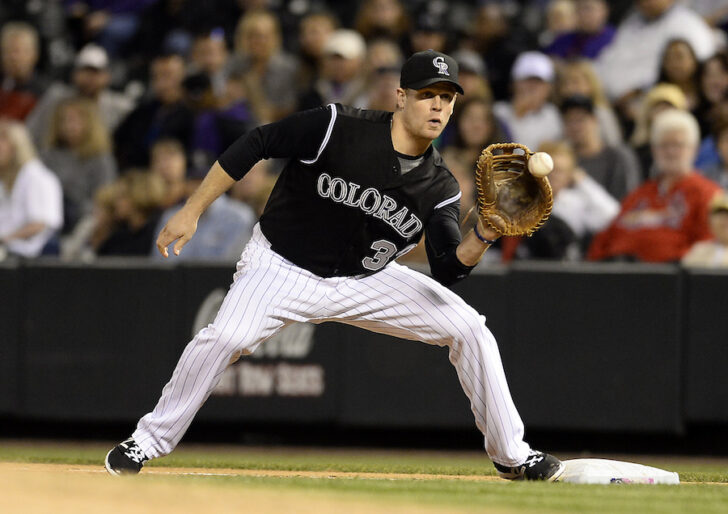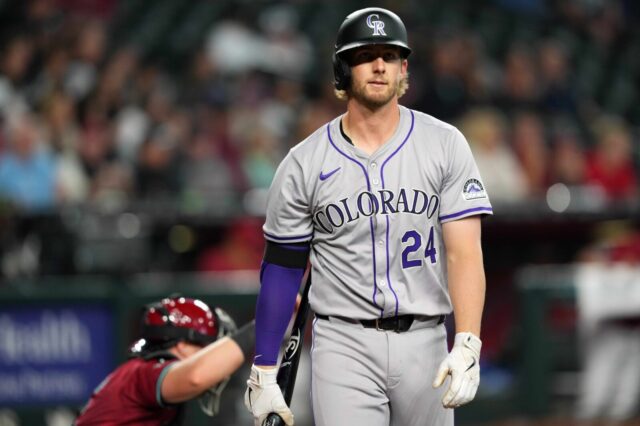Au Revoir Monsieur Morneau
The Colorado Rockies on Thursday declined their option with veteran first baseman Justin Morneau, making the 2014 NL batting champ, four-time All-Star and 2006 AL MVP a free agent effective immediately.
It’s probably best for both sides, as the Rockies need to look to the future at the position while Morneau, who has battled ongoing concussion issues since 2010, can now determine his own fate in the game. Most baseball fans are rooting for a farewell tour with the Twins, or, if complete honesty rules the situation, at least a ceremonial signing so that he can retire with the team that drafted him in 1999.
With Morneau playing just 49 games in 2015, Colorado was granted an extended look at the two leading candidates to replace him: Wilin Rosario and Ben Paulsen. While a platoon effort might be in the making again – Rosario played 53 games at the corner position (46 starts) while Paulsen made 66 starts and 91 appearances there – there’s reason to put one of them at the position on a more permanent basis, at least in 2016.
Big Ben Fits the Bill
Paulsen looks like a first baseman in the traditional sense. He’s long (6-foot-4), lean (210 pounds) and steely-eyed. He’s a virtual carbon copy of Morneau, physically, and in his first (nearly) full year in the big leagues he hit .277 with 49 RBI. His left-handed bat, also like Morneau, gives manager Walt Weiss more chances to alternate left-right-left deep into the lineup. He’s an above-average defender at first who can also play the outfield. And at 28 years old, Paulsen’s limited Major League experience belies his maturity as a player.
In most circumstances, those would all be considered positives. Paulsen fits the bill in a long line of Rockies first basemen like Andres Galarraga, Todd Helton and Morneau (if not quite the hitter that those three were). By all measures, he seems like the guy who should walk into Spring Training with the starting job in hand. But things aren’t so clear-cut in Colorado.
Behind, or perhaps beside, Paulsen is 26-year-old Wilin Rosario, the enigmatic catcher (not) turned third baseman turned first baseman and interleague designated hitter.
Baby Bull on the Loose
The Rockies have been trying to find a suitable home for Rosario since 2012, when he played 105 games (100 starts) behind the plate as Colorado’s No. 1 catcher. Rosario’s inconsistent play behind the plate and inability to handle a young pitching staff (to be fair, Rosario was just 23 himself) was a major factor in what was the worst season in franchise history (98 losses). Despite that, he was fourth in NL Rookie of the Year voting thanks to his .270 average, 28 home runs and 71 RBI.
The team improved by 10 games in 2013, where Rosario made 103 starts at catcher, and while his offensive stats (.292, 21 HR, 79 RBI) were solid, he remained a defensive liability and marginal came caller. Throughout that stretch and into 2014, where he started 94 times behind the dish, the Rockies experimented with him at third base and first base. For as bad as he was behind the plate, he looked worse at either corner position.
Fast forward to 2015. With Nick Hundley in at catcher, Colorado committed Rosario to a backup role both behind the plate and at first base where Justin Morneau was coming off a career-best .319 year and NL batting title. Morneau’s concussion injury thrust Rosario into a starting role at first base in early May. Paulsen joined the club shortly thereafter and spent most of May platooning between left field, in place of the also-injured Corey Dickerson, and at first when matchups dictated.
Better defensively, Paulsen got the starts in interleague play while Rosario would DH, and as the year wore on and Brandon Barnes proved to be more than capable in left field (not to mention a spark plug in the clubhouse and the lineup), Weiss gravitated more and more toward a lineup that regularly featured Paulsen. As his playing time increased, so did his productivity. He hit .260, .277 and .278 with nine, 10 and 17 RBI in June, July and August, respectively. Rosario, meanwhile, had his worst year at the plate overall.
His .268 batting average was one point higher than 2014, but his on-base percentage dipped below .300 for the first time as a full-time big leaguer. His 6 home runs and 29 RBI totals were both career lows, as was his .416 slugging percentage and 87 games. It’s for that reason he should be the starter in 2016.
A Case for Rosario
Rosario struggled in parts of 2015 because he didn’t see consistent playing time. A June in which he hit .333 in 25 games was followed by a July where he saw action cut nearly in half and hit just .167. He played several rough games at first base, defensively, and was banished to Albuquerque as a byproduct of the Troy Tulowitzki trade, his second trip to the minors on the year. Both moves were, according to Weiss, a byproduct of other roster moves, not a result of his play. An earlier move in April was necessary because of an injury to Corey Dickerson and an already turbulent bullpen. The back-and-forth to Triple-A was a shot to Rosario’s confidence and it showed when he returned in September and hit just .250 with four extra-base hits.
Rosario was so disheartened by the poor season and lack of faith in him shown by the organization that he told the Denver Post on Oct. 2 that he would be open to a trade in the offseason. He wants more playing time and more at-bats, or an opportunity with a different organization. It’s a bullish statement from the “Baby Bull,” but one he’s earned the right to make.
Rosario may still be a bit miffed that Colorado brought in Nick Hundley to take his job behind the plate, but now he has a great opportunity to seize the role of starting first baseman. Colorado made an early investment in Rosario, brining him up to the big leagues full-time at just 23 years of age. He’ll be 27 when the season starts and has two more years until free agency.
His trade value is at an all-time low, given this past season and his vocal desire to be moved. Now is the time for Colorado to double-down and let Rosario know that the starting job at first base is his to lose heading into 2016. It will give him the shot in the arm he needs from a motivation standpoint and the consistent at-bats that will showcase his greatest strength. He showed some flashes of being a capable fielder at the position, and more time in the saddle will only improve his comfort there.
This may fly in the face of logic to some, as Paulsen (as outlined above) seems like the safest possible replacement for Morneau, but there’s a method to the madness.
Risk Has Its Rewards
First and foremost, Paulsen’s solid (but not overwhelmingly good) year could very likely be his ceiling. In his minor league career, spanning parts of seven years, Paulsen is a lifetime .277 hitter. In seasons in which he’s played more than 100 games, he’s hit as high as .311 (Advanced-A) and as low as .241 (Double-A). His home run totals have been in the high teens and 20s, with RBI totals routinely above 70. He posted an identical batting average this year at the big league level as his career minor league average, along with 49 RBI.
Clearly, Paulsen is consistent. He’s not nearly as volatile an option – in any capacity – as Rosario. He’s a superb insurance policy in case Rosario can’t get out of his funk and be the 30-plus home run and 85 RBI guy the Rockies believed they first signed and developed. It’s that consistency that gives Colorado the luxury of giving Rosario first bid at first base. Paulsen’s a level-headed, know-your-role guy who isn’t going to bark if his at-bats decline. If Rosario can take the bull by the horns, pardon the pun, Paulsen will still have a role as a late-inning defensive sub and a left-handed bat off the bench.
Paulsen is also an insurance policy in the outfield in case Corey Dickerson’s health continues to be an issue. He’s a natural first baseman by trade and Brandon Barnes is probably a better defensive outfielder than both Paulsen and Dickerson, but a lineup that includes Carlos Gonzalez, Nolan Arenado and Rosario is far more dangerous with Paulsen in place of Dickerson than Barnes. And if Rosario only plays marginally well at first base, Colorado can always consider a mid-season trade and roll Paulsen right back into the starting role.
The Rockies have made a significant investment in Rosario over the years, one our friends at Purple Row think will be tossed aside when the Rockies non-tender Rosario. But with the safety net of Paulsen behind him, Rosario deserves one last shot to prove he’s a capable two-way player before the Rockies consider moving him to (presumably) the hitter’s league. And if that move does eventually happen, it should be after Rosario has had the chance to improve his value by seeing consistent at-bats and getting back to being the kind of hitter he showed he can be through his first three years in the majors.



